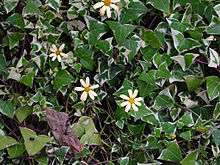Senecio macroglossus
| Senecio macroglossus | |
|---|---|
 | |
| S. macroglossus 'Variegatus' | |
| Scientific classification | |
| Kingdom: | Plantae |
| (unranked): | Angiosperms |
| (unranked): | Eudicots |
| (unranked): | Asterids |
| Order: | Asterales |
| Family: | Asteraceae |
| Subfamily: | Asteroideae |
| Tribe: | Senecioneae |
| Genus: | Senecio |
| Species: | S. macroglossus |
| Binomial name | |
| Senecio macroglossus DC. | |
Senecio macroglossus (Natal ivy, wax ivy) is a species of flowering plant in the family Asteraceae, native to southern Africa, from Zimbabwe and Mozambique to eastern South Africa. Growing to 3 m (10 ft) or more, it is an evergreen climber with waxy triangualr leaves to 8 cm (3 in) long. Single, yellow, daisy-like composite flowerheads are borne in summer.[1]
Despite its common name, and its resemblance to common ivy, it is not closely related to that group of plants. The Latin specific epithet macroglossus means "large tongue".[2]
With a minimum temperature of 5–7 °C (41–45 °F), it is frequently grown as a houseplant in temperate regions. Numerous cultivars have been developed, of which 'Variegatus', with cream-coloured leaf margins, has gained the Royal Horticultural Society's Award of Garden Merit.[3]
References
- ↑ RHS A-Z encyclopedia of garden plants. United Kingdom: Dorling Kindersley. 2008. p. 1136. ISBN 1405332964.
- ↑ Harrison, Lorraine (2012). RHS Latin for gardeners. United Kingdom: Mitchell Beazley. p. 224. ISBN 9781845337315.
- ↑ "RHS Plant Selector - Senecio macroglossus 'Variegatus'". Retrieved 3 June 2013.